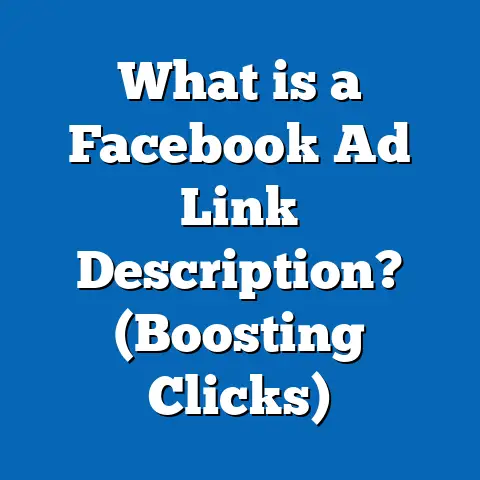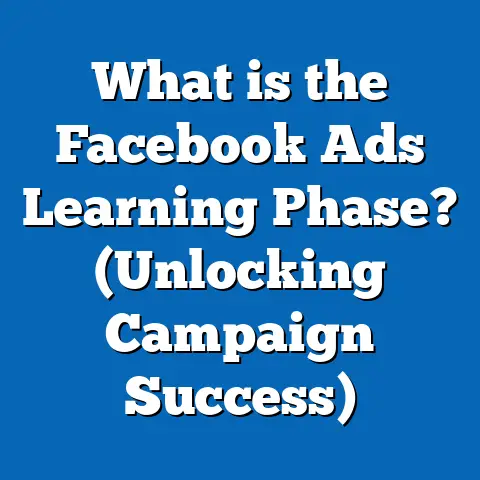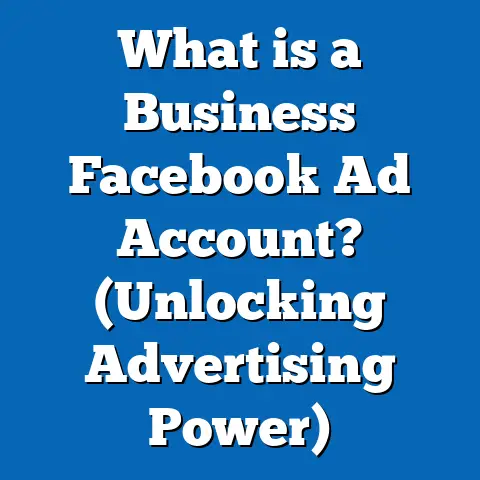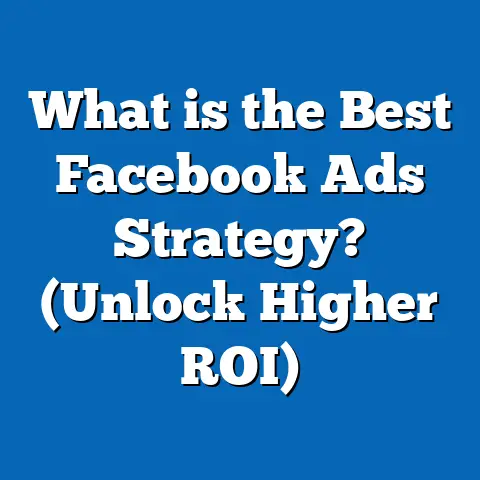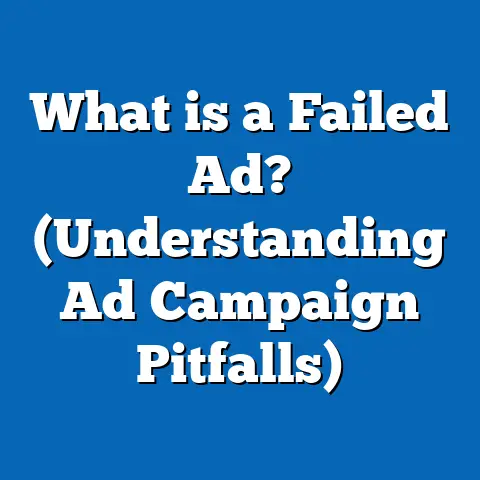What is Facebook Collection Ads? (Unlock Shopping Potential)
Introduction: The Rising Importance of Eco-Consciousness in Digital Marketing
In the past decade, consumer values have shifted dramatically toward sustainability and environmental responsibility. Today, eco-consciousness isn’t just a trend; it’s a core consideration influencing purchasing decisions worldwide. According to a Nielsen report from 2023, over 73% of global consumers say they would definitely or probably change their consumption habits to reduce environmental impact. This shift is especially apparent among younger demographics, such as Gen Z and Millennials, who are not only more aware of environmental issues but actively seek brands that align with their values.
For businesses and marketers, this means that eco-friendly messaging and product transparency are no longer optional—they are imperative to build trust and loyalty. Digital marketing channels offer unique ways to communicate these values visually and interactively. Facebook, with its massive active user base exceeding 3 billion monthly users across Facebook and Instagram combined (Statista, 2024), is a critical platform for brands aiming to capture this audience.
Facebook Collection Ads are a powerful format that combines eye-catching visuals with seamless shopping experiences. They allow brands to showcase multiple products within a single ad unit, providing an engaging narrative that can highlight sustainability stories effectively. This guide will explore the ins and outs of Facebook Collection Ads, from basic definitions and technical workings to advanced strategies and real-world applications focused on eco-conscious marketing.
What Are Facebook Collection Ads?
Definition and Core Features
Facebook Collection Ads are designed primarily for mobile users, providing a rich shopping experience directly within the Facebook or Instagram app. Unlike traditional ads that might link out to external websites, Collection Ads open an “Instant Experience,” a full-screen interactive environment that can include videos, images, product catalogs, and calls to action.
Key elements include:
- Primary Visual Asset: This can be a captivating video or high-quality image that tells your brand story or highlights a product feature.
- Product Thumbnails: A carousel of 3-5 product images that appear beneath or alongside the main visual.
- Instant Experience: When users tap on the ad, they are taken to a full-screen environment where they can browse products with detailed descriptions, prices, and links to purchase.
- Call-to-Action Buttons: These encourage users to shop now, learn more, or take other actions without leaving the platform.
The ad format is designed to reduce friction in the buyer’s journey by keeping users engaged within the familiar Facebook ecosystem.
Evolution from Carousel Ads
While carousel ads allow multiple images or videos in one ad unit, Collection Ads add an immersive layer by linking these visuals to an instant experience that feels like a mini e-commerce store. This reduces the need for users to leave Facebook and navigate external sites, which historically causes drop-offs in conversion.
Why Use Facebook Collection Ads? Unlocking Shopping Potential
The Mobile Commerce Explosion
Mobile commerce (m-commerce) has reshaped how consumers shop online. According to eMarketer’s 2024 forecast, m-commerce sales accounted for nearly 73% of total e-commerce revenue worldwide. Consumers expect fast-loading ads with simple navigation on mobile devices—exactly what Collection Ads deliver.
Increased Engagement and Conversion Rates
Data from Facebook’s internal research indicates that Collection Ads generate up to a 30% higher conversion rate compared to static ads or carousels. The immersive nature of the instant experience encourages viewers to spend more time exploring products, which correlates strongly with increased purchase intent.
Ideal for Storytelling Around Sustainability
Eco-conscious purchases often require more information than typical shopping decisions. Consumers want to understand product origins, materials used, certifications earned, and brand ethics. Collection Ads provide space for storytelling through video and text combined with easy access to product details, making them ideal for educating consumers on sustainability efforts.
Aligning With Consumer Expectations
According to a 2023 Accenture study, over 60% of consumers globally prefer buying from companies committed to positive environmental impact. Collection Ads allow brands not only to advertise products but also communicate their commitment transparently through video narratives or embedded content within the instant experience.
How Facebook Collection Ads Work: Step-by-Step Breakdown
Step 1: Crafting Your Creative Assets
Successful Collection Ads begin with compelling content. The primary visual can be:
- A video showcasing your eco-friendly manufacturing process.
- A lifestyle image emphasizing sustainability (e.g., model wearing recycled fabric clothing outdoors).
- A product highlight shot focusing on biodegradable packaging.
Below this primary visual, select 3-5 products from your catalog that align with the story told in the main image or video.
Step 2: Setting Up Your Product Catalog
Your product catalog should be connected via Facebook Business Manager. Make sure your catalog is up-to-date with accurate pricing, inventory status, and descriptions highlighting eco-benefits like organic certification or low carbon footprint.
Step 3: Targeting Your Audience
Use Facebook’s detailed targeting tools to reach eco-conscious shoppers:
- Interests: Sustainability, zero waste lifestyle, organic products.
- Behaviors: Online shopping habits indicating interest in green products.
- Custom Audiences: Retarget users who have visited your website or engaged with your content.
- Lookalike Audiences: Find new potential customers similar to your best eco-conscious buyers.
Step 4: Launching the Campaign
Create your campaign in Facebook Ads Manager:
- Choose “Conversions” or “Catalog Sales” as your objective.
- Select mobile placements (Facebook Feed, Instagram Feed).
- Upload creative assets.
- Set budgets and schedules optimizing for conversions.
When users see the ad and tap the primary visual or product thumbnails, they enter the Instant Experience where they can explore products in more detail.
Step 5: Analyzing Results and Optimization
Track metrics such as:
- Click-through rate (CTR): Measures initial interest.
- Conversion rate: Percent of users completing purchases.
- Return on ad spend (ROAS): Revenue generated per dollar spent.
- Engagement time within Instant Experience: Indicates how compelling your content is.
Use A/B testing for different creatives or audience segments to refine your approach continuously.
Data-Backed Insights: The Impact of Collection Ads on Shopping Behavior
Engagement Metrics
A Facebook study analyzing over 10,000 campaigns in 2023 found that Collection Ads had:
- An average engagement rate of 4.8%, compared to 3.2% for carousels.
- Users spent an average of 18 seconds within the Instant Experience—significantly longer than typical ad interactions lasting under 5 seconds.
Conversion Impact
According to WordStream data from Q1 2024:
- Brands using Collection Ads saw a median conversion rate uplift of 25%.
- Cost per acquisition (CPA) was reduced by approximately 15% compared to single-image ads.
- Return on ad spend (ROAS) improved by an average of 1.5x when using dynamic product feeds within Collections.
Consumer Preferences for Eco-Friendly Products
A survey conducted by GreenPrint in late 2023 showed:
- 70% of respondents preferred ads that provided detailed information about product sustainability.
- 55% were more likely to purchase products after seeing videos explaining eco-friendly practices.
These preferences align well with the capabilities of Facebook Collection Ads.
Practical Examples and Case Studies
Case Study 1: Eco-Friendly Fashion Brand – “GreenThread Apparel”
Background: GreenThread Apparel focuses on sustainable clothing made from recycled materials. They wanted to increase direct-to-consumer sales while educating customers about their zero-waste manufacturing process.
Strategy: GreenThread created a Collection Ad featuring a video showcasing their production process—from recycling fabric scraps to finished garments—with product thumbnails highlighting their best-selling recycled cotton tees and organic cotton hoodies.
Results:
- A 35% increase in online sales within one month.
- A 50% higher engagement rate compared to previous carousel ads.
- Cost per acquisition dropped by 20%.
- Customer feedback indicated increased brand trust after viewing the process video.
Lessons: Storytelling combined with product discovery drives both engagement and conversions effectively for eco-conscious brands.
Case Study 2: Organic Skincare Company – “PureGlow Organics”
Background: PureGlow Organics specializes in certified organic skincare products. They wanted an immersive way to educate customers on ingredient sourcing while showcasing multiple products in one ad.
Strategy: The company used Collection Ads featuring a soothing video about ethically sourced ingredients paired with thumbnails of their top lotions and serums. Inside the Instant Experience, they included customer testimonials focused on natural benefits and certifications like USDA Organic.
Results:
- A 40% lift in add-to-cart actions during the campaign.
- Repeat purchase rates increased by 15%, indicating stronger customer loyalty.
- Post-campaign surveys showed a 30% increase in brand favorability among targeted audiences.
Lessons: Combining educational content with social proof inside the instant experience enhances consumer confidence and drives sales.
Case Study 3: Sustainable Home Goods – “EcoNest Living”
Background: EcoNest Living sells reusable kitchenware aimed at reducing plastic waste. Their challenge was attracting new customers unfamiliar with sustainable alternatives.
Strategy: They launched a collection ad campaign featuring user-generated content highlighting their bamboo utensils and silicone food wraps in use. The instant experience allowed browsing through multiple product categories such as kitchen tools, storage containers, and cleaning supplies.
Results:
- New customer acquisition increased by 45%.
- Average order value grew by 10% as customers added multiple items.
- Social shares of the ads increased organic reach by an additional 20%.
Lessons: Leveraging authentic user content in collection ads can boost credibility and attract new audiences efficiently.
Technical Concepts Explained Simply
Instant Experience (Formerly Canvas)
Instant Experience is like a mini website built within Facebook’s app that loads instantly when tapped. It offers an immersive space where brands can combine videos, images, text blocks, product catalogs, forms, and buttons—all optimized for mobile users.
Why it matters: Instead of clicking an ad and waiting for an external website to load (which often results in drop-offs), users stay within Facebook, enjoying smooth navigation that increases likelihood of purchase.
Dynamic Product Feeds
Dynamic product feeds automatically pull real-time data from your inventory catalog into your ads. This means if a product goes out of stock or prices change, your ad updates instantly without manual editing.
For eco-conscious marketers managing multiple SKUs (e.g., organic lotions with various scents), this ensures ads are always accurate and relevant—key for maintaining customer trust.
Optimization for Conversions Using Machine Learning
Facebook’s algorithms learn which users are most likely to convert based on past behavior patterns. When you set “Conversions” as your campaign objective and use Collection Ads:
- The system targets users who have shown interest in similar products.
- It tests different ad variations automatically.
- Budget allocation shifts toward high-performing segments dynamically.
This reduces wasted spend while maximizing sales opportunities.
Comparing Facebook Collection Ads With Other Formats
| Feature | Facebook Collection Ads | Carousel Ads | Single Image/Video Ads | Stories Ads |
|---|---|---|---|---|
| Mobile Optimization | Very high | High | Moderate | Very high |
| Multi-product Showcase | Yes | Yes | No | Limited |
| Interactive Instant Experience | Yes | No | No | Yes (full screen) |
| Conversion Rate | Highest (avg. +30%) | Moderate | Lower | Moderate |
| Engagement | High due to rich media & browsing | Moderate | Low | High |
| Ease of Setup | Moderate | Easy | Easy | Easy |
| Use Case | E-commerce & storytelling | E-commerce & storytelling | Brand awareness & promos | Brand awareness & quick offers |
Advanced Tips for Maximizing Facebook Collection Ads
Use High-Quality Video Content
Video captures attention faster than static images. For eco-conscious brands:
- Show manufacturing processes emphasizing sustainable methods.
- Highlight certifications visually (e.g., organic labels).
- Demonstrate product use cases reducing waste (e.g., refillable containers).
Keep videos under 30 seconds for maximum engagement.
Incorporate Customer Testimonials Within Instant Experience
Authenticity drives trust. Include quotes or short videos from satisfied customers emphasizing product quality and environmental impact.
Example: “Since switching to GreenThread Apparel’s recycled cotton tees, I feel good about what I wear—and the planet benefits too!”
Test Dynamic Product Sets for Personalization
Use dynamic ads within Collections so each user sees products tailored based on their browsing history or purchase behavior. Personalized experiences increase relevance and conversions substantially.
Optimize Targeting With Lookalike Audiences
Create audiences similar to your best customers who value sustainability. Facebook’s lookalike tool uses machine learning to find new users matching key traits like purchase history or engagement patterns.
Leverage Seasonal Campaigns Focused on Eco-Friendly Holidays
Capitalize on events like Earth Day, World Environment Day, or Plastic-Free July by creating special Collections showcasing limited edition sustainable products or discounts tied to these themes.
Latest Trends and Features (2024 Update)
Augmented Reality (AR) Try-On Integration
Facebook has recently introduced AR try-on technology within Instant Experiences allowing shoppers to virtually test products before buying—for example:
- Trying on sustainable sunglasses made from recycled materials.
- Visualizing eco-friendly furniture in their home environment.
This feature enhances user confidence and reduces returns.
Enhanced Analytics Dashboard
New reporting tools provide granular insights such as:
- Heatmaps showing which parts of your instant experience receive most attention.
- Time spent per product section.
- Drop-off points where users exit the experience prematurely.
These insights help refine creative elements dynamically.
Cross-platform Sync Between Facebook Shops and Instagram Shopping
Improved integration ensures consistent product catalogs across Facebook and Instagram Shops—important since many eco-conscious shoppers switch between platforms seamlessly during their research phase.
Common Challenges When Using Facebook Collection Ads & How To Overcome Them
Challenge #1: Creating Engaging Video Content
Solution: Invest in professional videography or user-generated content campaigns focused on sustainability stories. Short animations explaining complex processes work well too.
Challenge #2: Keeping Catalogs Updated
Solution: Automate catalog syncing using Facebook Pixel or API integrations so inventory changes reflect immediately in ads—critical during busy shopping seasons or product launches.
Challenge #3: Balancing Storytelling With Sales Focus
Solution: Use a layered approach—start with emotional storytelling in videos followed by easy access to purchase options within thumbnails ensuring clear paths for action-oriented users.
Practical How-To Guide For Marketers Setting Up Their First Facebook Collection Ad Campaign
Step 1: Prepare Your Product Catalog
Ensure all eco-friendly products you want featured are uploaded into Facebook Business Manager’s Catalog Manager with clear descriptions emphasizing sustainability attributes such as:
- Organic certifications
- Recyclable packaging
- Carbon-neutral production processes
Step 2: Create Your Primary Visual (Video/Image)
Produce a short video or high-resolution image that tells your brand story or highlights key eco-benefits succinctly. Keep branding consistent with your website and offline materials for recognition.
Step 3: Build Your Instant Experience Template
Use Facebook’s drag-and-drop Instant Experience builder:
- Add text blocks explaining sustainability features.
- Embed customer testimonials.
- Link directly to product pages with clear call-to-action buttons like “Shop Now” or “Learn More.”
Step 4: Set Targeting Parameters
Select demographics focusing on interests related to green living and organic products. Consider layering behaviors such as online shopping frequency or previous engagement with similar brands.
Step 5: Launch & Monitor Performance
Run your campaign for at least two weeks before making optimizations based on performance metrics like CTR and ROAS. Use split testing for different creatives or audience segments concurrently to identify winners faster.
Summary & Clear Next Steps for Marketers
Facebook Collection Ads provide an unmatched opportunity for eco-conscious brands to combine rich storytelling with seamless shopping experiences tailored for mobile-first consumers. Marketers should:
- Invest in compelling visual storytelling highlighting sustainability.
- Use dynamic catalogs integrated with real-time inventory data.
- Target audiences deeply interested in environmental issues using Facebook’s robust tools.
- Track performance meticulously using granular analytics dashboards.
- Experiment with AR try-on features and cross-platform shopping integrations.
- Continuously optimize campaigns based on data insights and evolving shopper behavior trends.
By adopting these strategies now, brands can capture growing market segments passionate about ethical consumption while driving measurable sales growth through social commerce on Facebook.
If you want me to expand any particular section further — such as detailed setup walkthroughs inside Facebook Ads Manager, deeper analysis of AR technology’s impact on shopping behavior, or additional case studies from diverse industries — just let me know!

